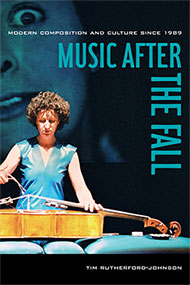23 February 2017
Writing about a global new music
 Image: Detail of the Music after the Fall cover, with the former ELISION cellist Rosanne Hunt performing a John Rodgers work.
Image: Detail of the Music after the Fall cover, with the former ELISION cellist Rosanne Hunt performing a John Rodgers work. Tim Rutherford-Johnson writes about his new book Music after the Fall, just published by the University of California Press. You can read more of Tim's writings on his blog page - see also his Spotify playlist of music related to the book.
Sitting in Europe it is all too easy to forget that Western art music - classical music - is not so much a Western culture today as it is a global one. This is even more true of contemporary and experimental art music, forms of which may be found in almost every country in the world.
When I began writing Music after the Fall, a survey of contemporary art music since 1989, I wanted to give a sense of that global spread. So, while the book features American string quartets and European orchestras, it also includes Korean composers, Lebanese improvisers and South American electroacoustic studios. When it came to Australian music, I was lucky to have the ELISION ensemble almost on my doorstep, as ensemble-in-residence at the University of Huddersfield in the north of England in 2009-2010.

This was when I began to seriously think about writing a book like this, and the inspiration I drew from ELISION's players and repertory, as well as many stimulating - and revealing! - conversations with their artistic director, Daryl Buckley, is acknowledged in the book's cover image, a photo of former ELISION cellist Rosanne Hunt performing in John Rodgers' TULP the body public.
A year or two before this I had also became aware, via the internet, of NMA (New Music Articles) magazine, and its series of tapes of experimental music released between 1982 and 1992 and reissued on MP3 in 2006. I loved digging through these - an archive of strange, surprising and often remarkable music of which I had been completely unaware. Those recordings introduced me to artists such as Ros Bandt, Chris Mann, Jon Rose and Amanda Stewart, all of whom are namechecked in the pages of my book.
Music after the Fall isn't organised by geographical divisions, however. There isn't an 'Australia' chapter, just as there isn't a 'Japan' one or a 'Germany' one. Sticking with my idea of trying to represent contemporary art music as a global phenomenon, I chose more global themes for my chapter headings - such as fluidity, mobility or loss - and made an effort to include a wide spread of musicians within each chapter. Liza Lim's music, for example, features towards the end of my chapter on 'mobility', that is, the practical and aesthetic consequences of globalisation (a chapter that also includes the American Pamela Z, the South Korean Unsuk Chin, and the Brit Michael Finnissy). Much of her music deals with intercultural encounters of some sort or another, and the composer has devised various methods by which she approaches the music of other cultures with respect and sensitivity. Her cello piece Invisibility is one such piece, composed following her experience in Arnhem Land of Yolngu art and ritual. More than a model for intercultural exchange, however, Invisibility draws on Yolngu knowledge systems to highlight the difficulty of truly knowing another's way of life, the carefully and rightfully guarded barriers to understanding that exist.
I only know Australia a little, visiting just once nine years ago, so I'm wary about making generalisations. But looking from a distance it's possible to hear continuities between the work of artists in ELISION's sphere of activity - John Rodgers, Liza Lim or Tim O'Dwyer, for example - and the more overtly experimental work featured in NMA. Many of them have an interest in landscape, whether that is the post-industrial setting of Lim's Bar-do'i-thos-grol or Rose's experiments playing the great fences of the Outback. Likewise there is a fascination with pushing instruments to - and in some cases beyond - their limits, as in O'Dwyer's saxophone playing or Stewart and Mann's virtuoso vocals.
All of these come together in Ross Bolleter's work with ruined pianos - 19th-century instruments left abandoned in barns and on rural verandahs, collected by the composer and coaxed back into life through improvisations that work with the grain of their decrepitude and decay rather than against it. These are certainly instruments taken beyond their typical limits, and their sounds tell of the landscape in which they were found, its sun, rain, plants and animals. Yet Bolleter is able to draw beautiful music from them that somehow telescopes all that history into one performance. Imported from colonial Europe and bearing the legacies of Beethoven, Schumann and Chopin, these weather-blasted pianos may not look like much, but they have much to say about classical music's globalisation, both now and in our past.
Further links
Tim Rutherford-Johnson: Music after the Fall (University of California Press, 2017) - book and ebook details on the publisher's website
Tim Rutherford-Johnson - blog (http://johnsonsrambler.wordpress.com)
© Australian Music Centre (2017) — Permission must be obtained from the AMC if you wish to reproduce this article either online or in print.
Tim Rutherford-Johnson is author of Music after the Fall: Modern Composition and Culture since 1989 (University of California Press). He edited the most recent edition of the Oxford Dictionary of Music, and blogs about contemporary music at johnsonsrambler.wordpress.com.
Comments
Be the first to share add your thoughts and opinions in response to this article.
You must login to post a comment.